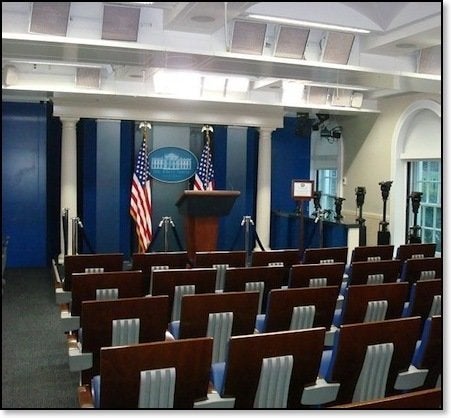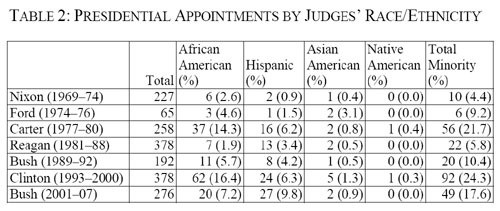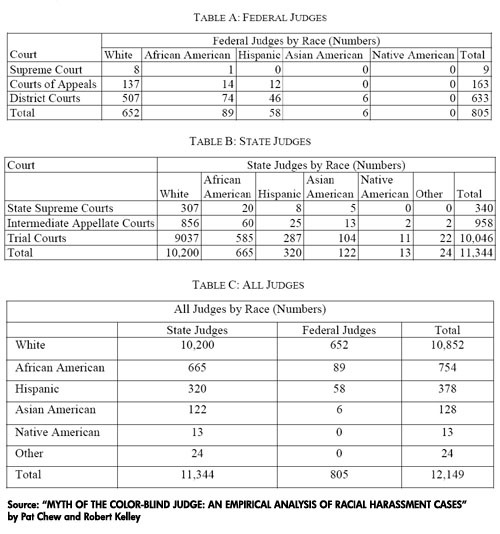
Perhaps President Obama will find the hill of health care progress too steep to climb, the unaudited vaults of the Fed too guarded to unlock and the political powers too polarized for bipartisanship, but before his historic first term in office is complete, there is a mountain he can successfully climb. The president has authority to appoint federal judges that can have tremendous impact upon American society and, over time, bring about a lasting change in at least one branch of government for which generations of Americans have hoped.
Changing Judicial Views Toward Workplace Discrimination
The numbers of racial harassment lawsuits each year have soared since Title VII was made law in 1964 -- the vast majority of cases quickly dispensed by judges whose limited perspectives seemingly seeped into their rulings. But as the racial makeup of the bench gradually evolves to incorporate more minorities and diversity increases within our system of jurisprudence, hearings in cases involving racial discrimination will produce dramatically different results. A new report presented at the 2010 Midyear Meeting of the American Bar Association on Feb. 5, concludes:
"Our interpretation is that race affects a judge's ability to appreciate the perspective of a plaintiff of another race. Thus, White judges as a group are less able to identify and empathize with African American plaintiffs, making it inherently more difficult to find the plaintiffs' arguments plausible and credible. This interpretation helps explain why White judges deny African American plaintiffs' claims so often.
"In contrast, it appears that African American judges are more capable of transcending their own demography and do not let color influence their decision making. They can identify with African American plaintiffs, but also with plaintiffs of other races. At the same time, African American judges still discern between more or less credible claims, holding for plaintiffs only about half of the time."
"Myth of the color-blind judge: an empirical analysis of racial harassment cases"
The comprehensive study, conducted by professors Pat Chew (University of Pittsburgh School of Law) and Robert Kelley (Carnegie Mellon University's Tepper School of Business), examined a random assortment of 40 percent of all reported racial harassment cases (more than 400) from six federal circuits between 1981 and 2003. They found a stark difference in the rulings of Black judges from their White counterparts.
Plaintiffs in racial harassment cases were ruled against more than half the time if the judge were Black (54 percent). But that percentage rose dramatically if the judge were White (79 percent) or Hispanic (81 percent). Asian American judges ruled against plaintiffs 67 percent of the time. The statistical canyon between the rulings of White and Black judges warranted particular attention by the researchers. Their in-depth findings ought to be required reading in every classroom across the nation that touches on the three branches of government.
Important Insight
Pardon my cynicism, but does it really take scientific research to convince a predominantly White power structure that it cannot effectively influence and govern a diverse population without an ability to relate to people of varying races and ethnicity? Surely, people can agree that diverse backgrounds and experiences within a decision-making body offer valuable insight and perspectives not held in general by those who lack similar backgrounds and relative experiences.
It seems obvious that race matters in professions that wield considerable amount of authority and power. Yet, walk into most any boardroom of the Fortune 500 companies, peek through a window into the executive suite of media's elite corporations or simply take a walk through the Senate chambers. The sea of White faces (primarily male from the Baby Boomer generation, offspring of "The Greatest Generation") in seats of power belies the sea of multicultural faces across the fruited plains.
If we perceived America through the prism represented by its authoritative and powerful institutions, we would conclude there is very little diversity in this country.
Demographic Diversity on the Bench
In the judicial system, less than 10 percent of attorneys are from a racial minority demographic. Black lawyers make up nearly 4 percent, while Hispanics are 3.3 percent. Asian American attorneys represent 2.3 percent and Native Americans 0.2 percent. Chew and Kelley argue for increased diversity in the pool of attorneys, since judges come from that pool. However, they caution the lack of greater diversity on the bench isn't caused by an insufficient number of qualified candidates within the pool.
Value of Diversity
The same is true in media. The overwhelmingly White power structure, in arguably the nation's most influential industry, largely ignores the value of diversity among its ranks. Yet, the availability of qualified leaders among groups of minority journalists is high.
The lack of diversity in the judiciary is a profound issue that fails to attract much attention by media, perhaps due to a lack of concern among the industry's White decision-makers. If the media continues to cut away at their lifeblood of journalists in order to slow financial hemorrhaging, important reports like the Chew-Kelley analysis will be lost in obscurity. Widespread public knowledge of the changing demographics in the judiciary and resulting impact from the bench, provides crucial data that raises the awareness of the electorate.
It is essential that judges have an ability to relate to a rapidly growing diverse culture and the experiences of minorities vulnerable to White people in positions of power within industries predominantly controlled by Whites. Minus some check and balance system that ensures proper treatment of employees regardless of race, creed, color or gender, there isn't much governance over the self-regulated actions of individuals who justify their mistreatment of others. A historical White bench sitting in judgment of White corporate leaders and managers has continued throughout history to rule overwhelmingly in favor of White corporate powers, creating a need for new laws enacted by Congress to empower the judiciary to punish offenders. Yet, laws alone aren't sufficient, as the report by Chew and Kelley reveals.
Hopeful Change
The growth of diversity on the bench is a welcome evolution of one of America's most powerful institutions and an encouraging factor. It offers hope that someday there will be a strong diversity of leaders in the institutions of power that reflects, to a large degree, the diversity of peoples in the U.S. population. The Chew-Kelley report is the beginning of a positive step that recognizes the need for change to the judicial status quo. They conclude:
"Since our study found that the racial make-up of the judiciary affects outcomes, a more diverse judiciary will bring more diverse views on what constitutes racial harassment -- ideally reflecting the range of views across all racial groups in society. With 80% of all federal judges (and 89% of all state judges) being White and our findings that White judges rule less favorably for racial harassment plaintiffs (who are typically African American), it is not surprising that some minorities place little faith in the judicial system.
"If people of all races are to believe in judicial fairness, a more diverse bench is a good place to start. Plaintiffs are less likely to feel marginalized when their experiences are viewed seriously. They are thus more likely to conclude the legal system is not biased. Legal principles prevail but are interpreted with the benefit of varied perspectives that are integral to the just resolution of racial harassment cases. Our study reinforces the need for the judiciary to be representative of the public it serves. Judges do not make decisions in racial harassment cases in a color-blind legal system. As a legal community and as a diverse society, we should not be blind to the color of judges."
If we can agree there is need to diversify judges sitting on the bench, can we also draw the same conclusion with regard to judges (decision-makers) sitting in political and corporate seats of power?


